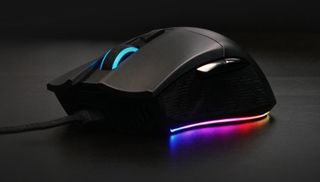What's the difference between CPI and DPI?
Both are used interchangeably when talking about gaming mice, but they mean different things.

There's a bit of complicated terminology that goes along with gaming mice, whether we're talking about sensors, acceleration, max speed, or even syncing the RGB lighting with the rest of your system. Determining what is the best gaming mouse for you means finding one that really fits your hand, but one very important specification is the resolution, or DPI. Or is it CPI?
Even though most manufactures use DPI to designate the resolution measurement, it's not exactly the correct nomenclature. But it's become a more widely recognized term, so those manufactures just roll with it. Logitech, for example, uses DPI while Steelseries uses CPI. In the case of gaming mice, DPI and CPI are referring to the same thing, but if you want to get technical, they actually have completely different meanings.
But even though they have different meanings and measure different things, they can still technically refer to the same thing depending if you are on the consumer-side or manufacture-side of things. Buckle up, it's about to get complicated.
What is DPI?
DPI stands for dots per inch, which most commonly measures the output resolution of a printer. It refers to the literal ink density on a piece of paper, but is also somewhat confusingly used to designate the pixel density of an image, too, even though that's a different medium.
The higher the DPI, the more tightly packed the dots on the page. And the more tightly packed the dots, the more detailed the image can be. That means you can print at a larger size without scaling up an image, which will make it blurry.
It works the same way as PPI, or pixels per inch, which measures the pixel density of a monitor or digital image. Both, however, are not the same as monitor or image resolution, which is the measure of the total number pixels in the display or digital image, even though in programs like photoshop the PPI is still referenced as the resolution.
So, DPI is for print and digital, and PPI is for digital only, and resolution can mean the 'count' of a few different things. With me so far?
The biggest gaming news, reviews and hardware deals
Keep up to date with the most important stories and the best deals, as picked by the PC Gamer team.
What is CPI?
So, if that wasn't confusing enough, CPI stands for counts per inch, which generally refers to the sensitivity of a mouse. The higher the CPI, the more sensitive it is to your movements. You can look at it as the number of 'steps' the mouse's sensor reports to your computer when it movies one inch, but what the number really is referencing is how many pixels fit into one inch on the surface of the mouse sensor, which is a bit like the CMOS sensor of a digital camera.
So, when you look at a mouse's sensitivity range, let's say 100-12,000, that means it can make anywhere between 100 to 12,000 steps per inch. A lower number will make the mouse cursor appear to move more slowly, and you'll have to move your mouse further across your desk to get the cursor to move to the other side of the screen. A higher number will require less movement on your part.
If your mouse has a little button beneath the scroll wheel, some manufactures might call it a DPI switch, but it's really a CPI switch. It also doesn't help clarify things when some manufactures like Logitech not only refer to its CPI settings as DPI, but refer to it as the 'resolution' range as well.
CPI gets even more complicated when you factor in a few more things. Mouse makers often subdivide the sensor's pixels to put a bigger number on the box, which isn't actually great for performance. And CPI isn't the only measure of mouse sensitivity, since games also let you adjust sensitivity up or down. If you want to understand more about the resolution of a mouse sensor, check out our gaming mouse myths busted feature, where a Logitech engineer breaks it down in detail.

Why is DPI used now instead of CPI?
The easy answer is that it's a more recognizable term to the general public. The complicated answer is that both terms are actually correct when we're talking about mice and their sensors. We're just talking about the same measurement from either the point of view of the display or the sensor itself.
For the end-user, it's more common to say DPI because we're the ones looking at our screen as our cursor moves around. But when we're talking about the mouse sensor itself, it's CPI. Like I previously mentioned, the sensor counts how many pixels it can put into one inch of whatever surface your mouse is on. This is also called the optical resolution. The monitor displays how fast your cursor is moving based on your DPI setting. Both reference the same thing, just from the point of view of two different devices.
There's longer history with DPI having multiple meanings, and this Microsoft blog goes into a lot more detail, but since optical and laser sensors became standard on mice, DPI became commonly associated with them, a sort of catch-all term since the '80s, and people have just become used to it. All of the mice manufactures on our best-of list use the DPI nomenclature on their websites, aside from Steelseries. But if you see DPI instead of CPI or vice versa, it ultimately means the same thing—mouse sensitivity.
Most Popular


